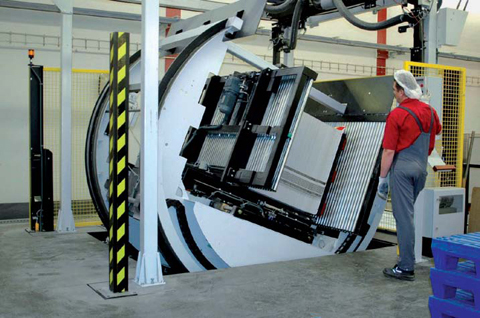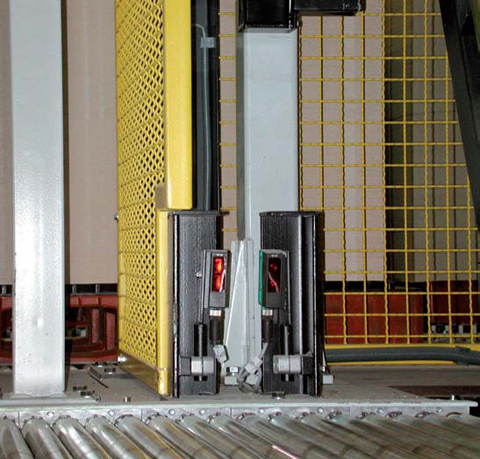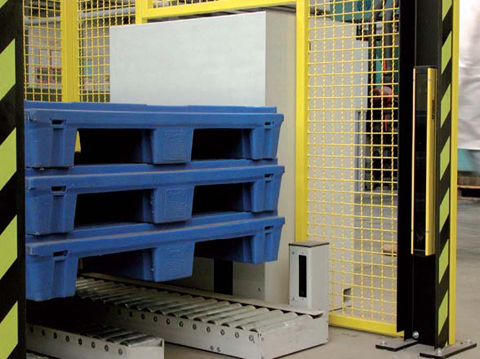Safe Stack Turners and Logistics Systems in the Printing Industry
Modular safety system exploits rationalization potential
Safety technology is far more sophisticated for many applications compared to only a few years ago. Heavy-duty machines are much faster and require an efficient logistics system. A typical example in the printing and paper industry is the machine engineering specialist Krifft & Zipsner GmbH. The company is an important partner for logistics and printing preparation. Krifft & Zipsner GmbH uses Safebox (safety technology) from Pepperl+Fuchs. With its compact design, flexibility and easy configuration, SafeBox safety monitoring system contributes to the rationalization of the systems.

Fig. 1: Stack turner for printed sheets
Printing machines are among the most complex and expensive products in the machine engineering industry. To ensure the amortization of high acquisition costs, machine downtimes must be avoided. Due to increased printing capacity, automation of logistics processes is critical. Printed sheets must arrive at the feeder and be delivered without process delays. With every unnecessary machine stop, the printing and ink parameters must be reset and optimized, adding time, waste, and cost to the process.
Smooth logistics on heavy duty machines are indispensable
Krifft & Zipsner GmbH, headquartered in Steinebach/Sieg, has 50 employees, specializes in logistics and automation in the field of printing and punching machines and is known to produce cutting-edge technology in this field. The product range focuses on intelligent stack turners with jogger and ventilating systems, transfer carts, rotary disks and roller, chain and belt conveyors, including vertical conveyors (elevators).
The logistics systems provide automatic processes at the delivery and the feeder of the printing and punching machines, thus ensuring a consistently high output with non-stop processes while decreasing the work load of personnel. Frank Schmitt, System Manager of Krifft & Zipsner, said: "One of our trademarks is that no component or product comes off the rack. We design and customize the systems in such a way that they can be smoothly integrated into already existing systems."
Turning, jogging and ventilation combined in one process
Cardboard or printed sheets are delivered to the printing machine operator on many different types of pallets, including single-use pallets. The pallets are transported on transfer carts from receiving storage to the stack turners, which play an important role in the process of central (printing) preparation. Depending on how long a printed sheet stack has been in storage, the stack weight may result in individual sheets adhering to each other. This applies in particular to the sheets at the bottom of the stack that bear the total weight.
Multiple sheet in feeds must be avoided because they disrupt the process flow of the printing machines. Stack turners ensure that this cannot happen by turning the complete printed sheet stack by 180 °. During this process, the printed sheets are jogged, ventilated and straight-edge aligned with the corresponding devices. Afterwards, the stack turner removes the wooden or single-use pallets and replaces them with a system pallet. The paper stacks, treated and straight-edge aligned, are now ready for the printing process. On printing machines with non-stop pallet (system pallet) at delivery, the stacks must be centrally aligned. The stacks are then transported to the printing machine via transfer carts.
Safety sensors for personal protection
Personal safety instructions must be observed for all machines that might cause injury. Injuries due to operator error must be avoided and controlled with proper safety procedures. Assuming that a pallet with printed sheets weighs between one and one and a half metric tons, a stack turner would have to use extreme force when moving, jogging or ventilating a stack (see Fig. 1). All operator-accessible points on the machine are monitored with light barriers and light grids. Pepperl+Fuchs SLA29 sensors are permanently active safety light barriers. Their detection range is extended by means of adjustable mirrors as far as this is useful. Depending on the risk potential, SLC30 safety light curtains may be required as an option for hand protection.
Muting for automatic loading and unloading
To bridge the safety system when a stack is automatically fed into or out of the machine, a muting device is installed. The device consists of four light sensors, positioned opposite each other in pairs that are used as muting sensors. Their detection range is set to half of the monitored path. Depending on the movement direction of the load during in feed and out feed, either the inner or the outer pair of sensors activates the muting (see Fig. 2).

Fig. 2: Muting sensors
Krifft & Zipsner GmbH supplies printing machines with automated logistics systems at delivery and in feed. The printing machines are equipped with SLP8-2 light grids that provide protection against dangerous movements on the pallet accumulator or the pallet dispenser (see Fig. 3). The light grids are two-channel light grids with active and passive column: the active side accommodates both the transmitting and receiving elements, while the passive side consists mainly of mirrors for deflecting the beams. Only the active side must therefore be connected to the mains.

Fig. 3: Pallet accumulator
Only one evaluation system for all safety sensors
All stack turner safety components are connected to the Pepperl+Fuchs safety evaluation system, Safebox. With this modular system, all safety sensors and switches in small and medium-sized systems can be configured according to requirements. Previously, Krifft & Zipsner had used four different switching devices by two manufacturers for every machine, for example, the SLVA-4K evaluation device for the permanent light barriers and the SLVA-8K for the muted light barriers. All of these functions are now performed by the Safebox in an easier and more rational way.
The SafeBox consists of an assembly carrier with backplane, which can be flexibly equipped with functional modules as required. Depending on housing size, between two to eight slots are provided with a total of up to 32 channels for connecting one-channel and two-channel sensors. The system is suitable for all standard photoelectric and mechanical safety systems and safety switches of category 1-4 according to EN 954-1. Multiple emergency stop circuits or switch groups can be created, e.g. to delay the shut-down of system components.
Configurable without PC
Another important reason why the logistics specialist Krifft & Zipsner decided to use Safebox is that it can be commissioned and maintained without using a PC. No programming, linking of inputs and outputs, address assignment or additional wiring is necessary to configure the system. Assembly-related functions are set via the DIP switches, while different switch groups are defined according to type and sequence of the modules in the equipment.
The SafeBox has the equipment approvals according to IEC 61496-1 and EN 61508 (SIL3) and supports the emergency stop functions of categories 0 and 1 as well as different muting types. In the event of an error, the error codes of a 7-segment display provide clear service information in connection with the indicator lamps on the corresponding modules to ensure that the cause of the error is located. If required, the error codes and the error logs can also be exported via an RS485 interface.
Safety solution from individual switching systems through to universal safety buses
Joachim Albertz, product manager for safety technology, said: "The Safebox bridges the gap between solutions with individual switching systems and expensive systems with safety bus by offering a flexible and modular system which can be adapted to the corresponding task. Up until now, separate evaluation systems, sometimes of different suppliers, were required for light barriers, light grids, switch panels, safety mats, emergency stop switches etc. Safebox reduces the scope of components necessary to one system with only a few components and easy storage."





 +61 3 9358 3400
+61 3 9358 3400